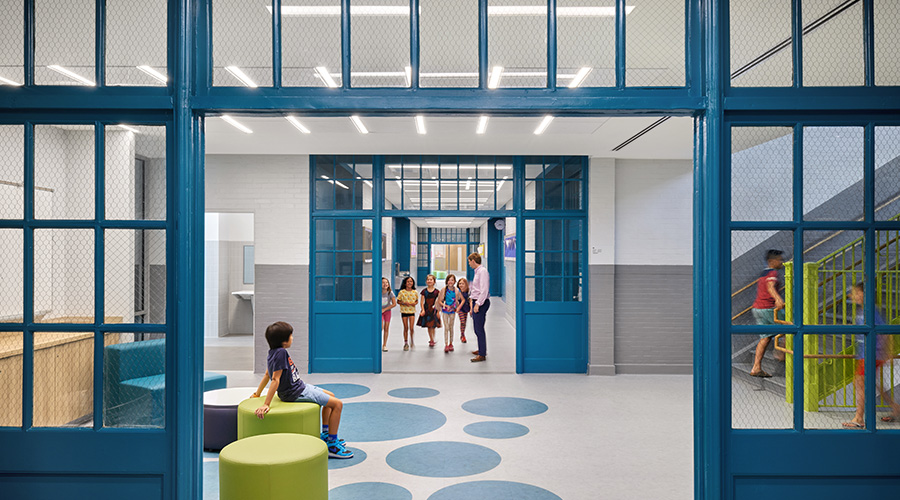 The Westerville City School District has upgraded a range of lighting, HVAC, and electrical systems in schools and other facilities over the last 12 years to create more effective learning environments and, in the process, has saved nearly $21 million in energy costs.
The Westerville City School District has upgraded a range of lighting, HVAC, and electrical systems in schools and other facilities over the last 12 years to create more effective learning environments and, in the process, has saved nearly $21 million in energy costs.Eye on Energy: Routine Maintenance Can Improve Efficiency
Westerville City School District rethinks and upgrades facilities to help students and save energy
The district’s front-line technicians have been key players in the upgrades, and they have been managers’ eyes and ears out in the field.
“We meet with our maintenance and custodial teams frequently to discuss program improvements,” Lerose says. “We encourage our school custodians, who are our front lines, to report concerns to the next level if they do not feel a situation is getting remedied in a timely manner.
The feedback also gives managers information on systems, equipment and components that might soon require upgrading or replacement as part of the district’s energy efficiency push.
“We meet regularly with the facilities teams — HVAC, plumbing, and electrical — and discuss difficulties in maintaining equipment,” he says. “If we are receiving repeat calls on the same issue after a repair was made, we work to develop an alternate plan or determine if replacement is warranted.
In a broader sense, a more comprehensive effort to gather and analyze information on maintenance activities and spending also is helping move the department from a reactive maintenance mode toward preventive and even predictive maintenance.
“Looking at our most recent annual expenditures, 36 percent, or $2.5 million, of our total facilities budget, including general funds and capital funds, is used by our maintenance department for routine repairs and preventive maintenance,” Lerose says, adding that this includes wages and benefits, while “64 percent, or $4.5 million, is for capital type building improvements, including equipment and building component replacement.
“We continue to analyze the information provided by our maintenance software and use this information to make improvements to our preventive maintenance program, all geared toward predicting building component failure before it occurs.
“We continue to focus on recognizing issues before customers recognized them. This is a stretch goal, but we strive to be so good at what we do that the customer never has to call with a complaint about building component malfunctions.”
Predictive maintenance is a far cry from the department’s approach when Lerose arrived after a career in the aerospace industry.
“In the early years, our approach was more about waiting for the customer to call and then responding,” he says. “My time in aerospace taught me that failure can be predicted. For those who challenge this belief, I ask if they would want to fly on a plane that is maintained under the philosophy that failure cannot be predicted.” Changing the maintenance strategy started with changing core tactics technicians had been using.
“We improved on our problem-solving skills by developing self-directed work teams focused on analyzing data to support their decision-making process,” Lerose says. “As we evaluated the work orders being received, our goal was to lower the percentage of calls from the customer and focus on improving our preventive maintenance program by moving from reactive to proactive.”
Through it all, the department’s customers — students and teachers — have remained the focus of their efforts.
“We want to be so good at what we do that we eliminate the need for the customer to call, all geared toward minimizing the negative impact on the learning environment,” he says. “We strive to provide our technicians the resources needed to perform their work — whether it’s a combustion analyzer to measure the efficiency of the boiler flame or infrared scanning equipment to determine the amount of heat coming off electrical gear.”
The benefits of moving away from reactive maintenance have included being able to devote more time to other strategies related to maintenance.
“Being less reactive has provided time for our maintenance department to get directly involved with our capital improvements program,” Lerose says. “The maintenance teams help in overseeing the work of outside contractors on our larger projects. The teams also share their perspective with architects and engineers as the scope of work is developed.
“Many school districts will hire a construction manager to oversee the construction work. Since 2004, all efforts for capital improvements in terms of construction management have been completed with in-house resources.”
The department’s future activities will focus in part on improving the condition of the Westerville City School District’s aging stock of buildings.
“Our district is working on a long-range facilities plan to address identified needs for school buildings 55 years and older,” Lerose says. “The foundation for this plan came from a community-driven committee that met over during a six-month period to analyze aging infrastructures, study student enrollment forecasts, review current and anticipated curriculum, and examine building safety and security.”
Related Topics:














